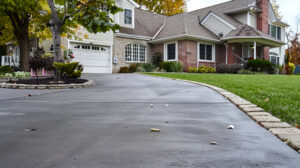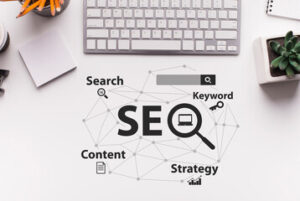For durability and visual appeal, driveway paving contractors choose pavers with patterns like herringbone or basket weave. They also ensure that drainage problems are addressed, such as putting in under drains or stabilizing the soil underneath the pavement.

Permeable pavers and grass-jointed paving are environmentally friendly options that enable natural drainage, which helps reduce stormwater runoff. Local regulations and permit requirements should be researched to avoid fines and delays. Contact Driveway Paving Charleston SC for professional help.
A gravel driveway is a low-cost option for homeowners looking to improve the appearance of their homes. The stones in a gravel driveway offer a rustic, natural look that can complement many different types of landscapes and home styles. In addition, a gravel driveway can help with water drainage, preventing erosion and reducing the need for resurfacing or regrading over time.
The key to a good gravel driveway is a balanced mix of materials that match utility and aesthetics. There are a variety of gravel options, ranging from steel slag and recycled asphalt product to more expensive crushed marble or limestone. Each type of rock has unique properties and benefits that should be carefully considered before choosing a material for your driveway.
Gravel is a loose, aggregate material consisting of stone and rock that’s commonly used for roads and landscaping projects. It comes in a variety of sizes, and it can be blended with other materials such as sand and clay to create a more stable surface for your driveway. Gravel is usually a cost-effective alternative to pricier asphalt or concrete, and it can last 10 to 20 years with proper care.
When installing a new gravel driveway, hardscaping professionals typically start with a base layer of rocks that’s about 4 inches thick. This provides a solid foundation for the rest of the layers and helps with drainage. A geotextile fabric should also be laid down to prevent weeds from growing through the gravel.
A middle layer of gravel that’s about the size of a baseball is then added, followed by a top layer that’s about the size of golf balls. A gravel driveway’s layers should be compacted thoroughly between each application to ensure a consistent and stable surface.
A properly installed gravel driveway isn’t maintenance-free, but it’s a good choice for budget-conscious homeowners or those living in rural areas with long drives who prefer a more natural appearance than a paved surface. You’ll need to occasionally re-grade your driveway, fill in potholes and add fresh layers of gravel as needed. You should also re-apply the top layer every few years to maintain its appearance.
Stamped Concrete Driveways
A modern alternative to pavers, stamped concrete offers a high level of customization for homeowners seeking a sleek, sophisticated look. It’s achieved by imprinting patterns, textures and colors into freshly poured concrete to mimic the appearance of higher-end materials like stone, wood, and brick — but at a more affordable cost. As a result, stamped concrete driveways offer exceptional beauty and resilience with a long lifespan that adds significant value to homes.
Driveways and walkways are the most popular uses for stamped concrete, but it’s also a great option for patios, pool decks, and interior flooring. Its flexibility allows for a wide range of design possibilities that can complement the style of any home and landscape. From the warm earth tones of natural stone to the clean lines of slate and ashlar, there’s sure to be a stamped concrete finish that fits your vision.
The versatility of stamped concrete offers endless design opportunities for homeowners seeking a unique driveway or walkway. From geometric patterns to more intricate motifs, the design options are truly limitless. Some designs include a focal point, such as a circle, swirl or square, that acts as a centerpiece for the overall design. Borders are another element that can help bring the design together. Some contractors can even install a special pattern that mimics the look of individual pavers, such as compass rose designs or lotus blossoms.
Color is another important factor when choosing a finished design. Stamped concrete is available in a wide variety of shades, from the earth tones of browns and tans to grays and charcoals, as well as redder tones of terra cotta. Choosing lighter shades can help reduce the heat island effect caused by dark asphalt surfaces, and it may even help lower energy costs in warmer months.
Unlike pavers, which require frequent de-weeding and re-sanding, concrete is a single slab that skips this maintenance. While sweeping and hosing down the surface can help keep it clean, all it usually takes is resealing once every few years to preserve color and prevent water damage and staining.
Edging and Borders
The edging and borders you choose for your driveway can add style, visual appeal, and structural integrity. Proper edging prevents the asphalt from spreading out of its intended boundaries and helps create clean, crisp lines for the entire paved area. It also reduces lawn maintenance and weed control by creating a defined separation between grass or flowers and the driveway.
Concrete, brick and paver edging are sturdy materials that provide a polished look for your driveway. They are also good for defining pathways or creating curves and geometric shapes in the landscape. They are also easy to work with, allowing you to cut them into various lengths for different designs and textures.
For a contemporary, minimalist design, metal edging is a great choice. It is a durable option that will withstand heavy traffic, and it comes in a variety of colors and finishes to complement your style. For a more rustic, organic look, try a scalloped terra cotta edging. It is easy to install, and it offers a unique texture that adds depth to your garden.
Wood edging is another popular choice, but it’s important to use pressure-treated materials to protect against rot and pests. It’s easy to install in straight lines or curves and can be painted or stained. Wood edging is also a good choice for defining raised planter beds.
Before constructing your paved area, prepare the soil by removing any low areas and adding in quality topsoil or loam. You may need to add in crushed rock or gravel as well. Check to see that the subgrade is suitable for paving, and consider adding in underdrains if necessary.
The surface course of the paving should be placed in one or more lifts to the true line and grade shown on the plans or established by your contractor. It is critical that the material be rolled and compacted thoroughly, with attention to eliminating all roller marks.
Maintenance
A well-maintained driveway can add a touch of elegance to your home and increase its value. However, a damaged or outdated driveway can take away from the curb appeal of your property and damage cars and tires that pull up to it. If your driveway is in need of repair or you are looking to install a new one, hiring a professional is a great way to ensure that the job is done correctly and lasts for years to come.
The most cost-effective option for paving is asphalt, which can also be recycled to reduce its environmental impact. It offers excellent durability, smoothness, and flexibility, as well as a wide range of colors, textures, and design options to suit your aesthetic preferences. Its easy installation and maintenance processes further position it as a favored surfacing material for residential properties.
Before a tar or chip driveway can be constructed, the site must be excavated and graded properly to ensure proper drainage and avoid settling. The subgrade should be stabilized with a soil sterilizing agent and any existing vegetation should be removed. Once the site has been prepped, a layer of crushed rock is then spread and compacted to create a solid base for the final pavement surface.
While a gravel or paver driveway is generally low-maintenance, it can become damaged by vehicles that drive over it regularly. To prevent this from happening, a silica sand layer can be placed on top of the gravel to help with traction and prevent damage. The sand should be replaced periodically as it becomes worn down.
Block paving is another durable and aesthetically pleasing choice for driveways. The many different colors, shapes and sizes of the pavers allow you to choose eye-catching designs that can boost your property’s curb appeal. While it requires more maintenance than gravel or tar, block paving is long-lasting and will last for a very long time if it is cared for properly.
To keep your block paved driveway in good condition, sweep the surface regularly to remove any dirt or debris. If there are any oil stains, try using household items like cat litter, concentrated dish soap, a can of Coke, baking soda, baby powder or even WD-40 to soak up the oils and grease. Make sure to hose the area down afterwards with clean water to ensure that it is completely cleaned.



